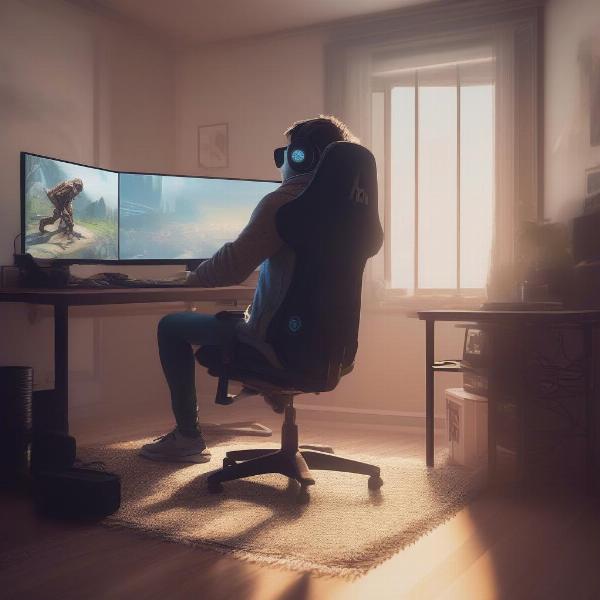At SupremeDuelist.blog, we delve deep into the world of gaming, analyzing everything from mechanics to the player experience. One common issue many gamers face is motion sickness while playing video games. This uncomfortable sensation, often referred to as cybersickness, can range from mild nausea to debilitating dizziness. We’re here to explore why this happens and what you can do about it, because understanding the root causes can help enhance your gaming sessions.
This article will examine the scientific reasons behind video game motion sickness, covering various triggers such as frame rates, field of view, and the types of games that are more likely to induce this condition. We’ll also delve into practical tips for preventing and alleviating the symptoms, including adjustments to your gaming setup and game settings. Additionally, we will look into the differences between motion sickness in real life and cybersickness, addressing frequent questions and providing clear advice for gamers seeking relief.
What is Cybersickness and Why Does it Happen?
Cybersickness, also known as video game-induced motion sickness, arises from a conflict between your visual perception and your inner ear’s sense of balance. When you’re playing a video game, your eyes perceive movement on the screen, but your body remains still. This discord between visual and vestibular information can confuse your brain, resulting in motion sickness symptoms, this is very similar to what is experienced when one wonders can video games cause vertigo. The more intense the visual simulation, the higher the likelihood of triggering these symptoms, and thus understanding the causes of cybersickness is the first step toward effective management.
 virtual-motion-sickness-cybersickness
virtual-motion-sickness-cybersickness
How Does the Brain Perceive Movement in Video Games?
Our brains rely on a delicate balance of sensory inputs to understand our position and movement in space. When you’re physically moving, your eyes, inner ear, and proprioceptors (sensors in your muscles and joints) all send consistent signals to the brain. However, when playing a video game, your eyes perceive movement while your inner ear and proprioceptors tell you that you are stationary. This is especially pronounced in fast-paced, first-person games where the visual field changes rapidly. This sensory conflict leads the brain to misinterpret the situation, often triggering a motion sickness response. Understanding this discrepancy is key to mitigating the unpleasant effects.
Common Triggers of Video Game Motion Sickness
Several factors within video games can trigger cybersickness, making some games more likely to induce this than others.
Frame Rates and Visual Stability
One of the most significant factors is the frame rate, which is the speed at which images are displayed on the screen. Low frame rates can cause the game to appear choppy and inconsistent, which may exacerbate the sensory conflict and make you feel sick. Conversely, high frame rates generally provide a much smoother and more comfortable visual experience, reducing the likelihood of motion sickness. Consistent frame rates are key to a comfortable gaming session.
Field of View (FOV) Settings
Another major contributing factor is the field of view. A narrow field of view can mimic tunnel vision, creating a more jarring and intense sense of movement. In contrast, a wider field of view, allowing you to see more of your simulated surroundings, can reduce the sensation of motion sickness because it provides more visual context. Adjusting FOV settings is one of the most effective ways to manage cybersickness, by offering a more natural visual experience.
Types of Games More Likely to Cause Motion Sickness
First-person games with rapid camera movement are notoriously known for triggering motion sickness. These types of games often involve quick turns, sudden changes in direction, and a constantly shifting point of view. In contrast, some less-demanding games that feature isometric or top-down perspectives, or games with slower pacing, are generally less likely to cause issues. Therefore, understanding what type of games tend to exacerbate the issue is vital for planning sessions and avoiding potential discomfort.
Specific Visual Effects
Visual effects like blurring, excessive shaking, and camera bobbing can also exacerbate the symptoms of cybersickness. These effects add to the sensory overload and further the discrepancy between the visual and vestibular systems. A game with many of these effects is more likely to cause problems even for players who normally do not experience them.
Tips and Strategies to Reduce Cybersickness
Thankfully, there are numerous practical steps you can take to manage and reduce cybersickness. These strategies range from making changes to your gaming setup to adapting your gaming habits.
Adjust Your Gaming Setup
One of the first things you should check is your gaming setup. Ensuring you have the correct display setup by moving closer to your screen may help improve visual clarity, thereby decreasing visual stress. Additionally, ensuring that you are playing in a well-lit room may reduce eye strain and thus indirectly aid in preventing cybersickness. Taking breaks regularly and avoiding playing for extended periods can make a significant difference in your overall comfort.
 setting-up-gaming-environment-to-reduce-cybersickness
setting-up-gaming-environment-to-reduce-cybersickness
Modifying Game Settings
Many video games come with settings that can help you adjust the gameplay to mitigate cybersickness. Adjusting field of view (FOV) is one of the most important, as a wider FOV can reduce the intensity of perceived motion, this is similar to preventing the effects of motion in the real world. Furthermore, disabling camera shake and motion blur may also ease your experience. These modifications can make your gaming experience smoother and more comfortable.
Simple, practical techniques.
Beyond game settings, there are simple techniques that can help reduce cybersickness. Some players report that turning on a fan can help, while others suggest that consuming ginger can soothe the stomach. Focusing on a static object in your environment during gameplay, or taking deep breaths while playing can also help to reduce symptoms.
Behavioral Adjustments
Making behavioral adjustments is also very effective. Start by taking breaks frequently when playing games, especially ones known to trigger cybersickness. If you start to feel unwell, it is important to stop playing immediately, since pushing through can make the symptoms worse. Gradually increase your gaming time once your body adjusts to the visual stimulation of the game.
The Difference Between Real-World Motion Sickness and Cybersickness
While similar symptoms may arise from both real-world motion sickness and cybersickness, the triggers are different. Real-world motion sickness typically occurs due to physical movement, such as in a car, boat, or plane where your inner ear senses motion, but your eyes might not. Cybersickness, in contrast, results from visual simulation, where your eyes sense motion, but your inner ear does not. Understanding these differences can help you identify the appropriate remedies. The core difference lies in the way the brain interprets the conflicting sensory information.
Expert Insight
“Cybersickness is a unique challenge in the modern gaming landscape,” explains Dr. Eleanor Vance, a neuroscientist specializing in sensory processing. “It stems from the brain’s confusion when visual motion doesn’t align with the body’s sense of balance. Tailoring game settings and personal habits is key to mitigating these effects.”
“Many players also find that ginger and other natural remedies can ease nausea, this is due to the interaction of the herbs with the gut, reducing gastrointestinal motility, which is often the first symptom of motion sickness. says Dr. Vance. ” It’s all about understanding and addressing the sensory conflict.”
Adapting to Cybersickness Over Time
With consistent exposure, many players can adapt to video games and experience reduced motion sickness symptoms. This adaptation, however, varies between people and can take time. Therefore, persistent application of the strategies mentioned in this article, including regular, incremental increases in playtime, may allow for players to increase their tolerance over time. It’s like training your brain to better interpret the visual stimuli of the game.
Frequently Asked Questions About Cybersickness
Can you build a tolerance to video game motion sickness?
Yes, with gradual exposure and consistent application of mitigating strategies, players can often build up a tolerance to cybersickness. The brain learns to better interpret the visual information.
What are the early signs of motion sickness in video games?
Early signs can include mild nausea, dizziness, lightheadedness, and increased sweating. It’s important to stop playing when you notice these symptoms.
Do certain types of video games cause more cybersickness?
Yes, first-person games with rapid movement and a narrow FOV are generally more likely to cause motion sickness. Slower games with top-down or isometric perspectives are less prone to this.
Does the type of display (monitor or VR headset) affect motion sickness?
Yes, VR headsets can sometimes worsen symptoms due to the immersive nature of the visuals, while specific monitor refresh rates and display settings can help to alleviate issues. Adjusting settings to your specific display is advisable.
Is there medication for video game motion sickness?
While over-the-counter motion sickness medications can help, it is often better to focus on adjusting in-game settings and utilizing lifestyle modifications to manage the symptoms. It is recommended to consult with your doctor before taking any kind of medication.
Conclusion
So, Can You Get Motion Sickness From Video Games? Absolutely. Cybersickness is a real phenomenon that can affect many gamers. However, by understanding the causes and implementing strategies to mitigate the problem, you can enjoy your gaming experience without discomfort. Remember, adjusting game settings, modifying your gaming environment, and taking regular breaks are all effective measures you can use. At SupremeDuelist.blog, we aim to provide you with all the knowledge you need to excel and enjoy the gaming experience. If you are interested in further topics, check out our content on whether can video games cause vertigo, for more useful information. Don’t let cybersickness get in the way of your gaming goals – implement these strategies today.
Leave a Reply